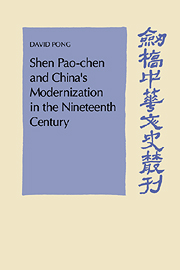Book contents
- Frontmatter
- Contents
- List of maps, tables, and figure
- Acknowledgements
- A note on spelling
- Abbreviations used in the notes
- Introduction
- 1 Early years
- 2 Local official in Kiangsi, 1856–1859
- 3 Governor of Kiangsi, 1862–1865
- 4 First encounters with foreigners
- 5 Director-general of the Foochow Navy Yard
- 6 The Foochow Navy Yard: early developments, 1866—1867
- 7 The Foochow Navy Yard: administration and personnel
- 8 The Foochow Navy Yard: building and training programmes
- 9 The Foochow Navy Yard: financial crises
- 10 The next steps in defence modernization: Ma-wei and beyond
- 11 Towards a plan for self-strengthening
- Conclusion
- Glossary of Chinese characters
- Bibliography
- Index
1 - Early years
Published online by Cambridge University Press: 22 September 2009
- Frontmatter
- Contents
- List of maps, tables, and figure
- Acknowledgements
- A note on spelling
- Abbreviations used in the notes
- Introduction
- 1 Early years
- 2 Local official in Kiangsi, 1856–1859
- 3 Governor of Kiangsi, 1862–1865
- 4 First encounters with foreigners
- 5 Director-general of the Foochow Navy Yard
- 6 The Foochow Navy Yard: early developments, 1866—1867
- 7 The Foochow Navy Yard: administration and personnel
- 8 The Foochow Navy Yard: building and training programmes
- 9 The Foochow Navy Yard: financial crises
- 10 The next steps in defence modernization: Ma-wei and beyond
- 11 Towards a plan for self-strengthening
- Conclusion
- Glossary of Chinese characters
- Bibliography
- Index
Summary
The city of Foochow, the capital of Fukien, was divided into two adminstrative halves by a major thoroughfare, with the Min district in the east and Hou-kuan in the west. But if the city were divided according to the character of its sectors, a northern quarter of government and religious buildings, straddling the two administrative districts, could be easily distinguished. In many ways, Foochow was just another southern Chinese city with its eleven-kilometre wall enclosing the various wards, each with its narrow and dirty streets, badly paved with blocks of granite. In size, it was a little bigger than Canton, but the affluence and lustre of the latter were lacking. The city wall, in fact, enclosed a considerable amount of wasteland. Foochow, however, was not without its charms. Its Curiosity Street displayed merchandise ranging from antiques and fine lacquer-wares to exquisitely executed rice-paper flowers. Three wooded hills rose above the horizon of the city, which also boasted many banyan trees in its public areas. The Chinese called it the Banyan City. But one inescapable feature of this provincial capital was the large number of officials among its six hundred thousand inhabitants and the space dedicated to government offices. Learning, and its close tie with office, was given expression by the academies and the examination halls, one with ten thousand cells. Foochow had traditionally produced more than its fair share of scholars and officials, both in the province and in the empire.
- Type
- Chapter
- Information
- Publisher: Cambridge University PressPrint publication year: 1994



